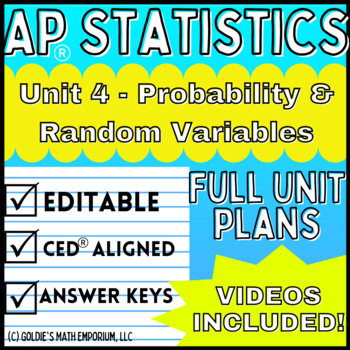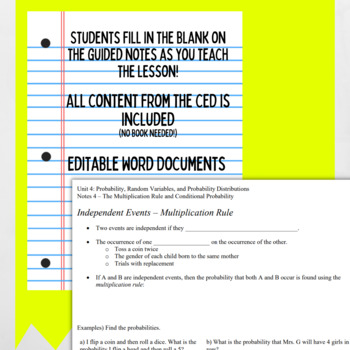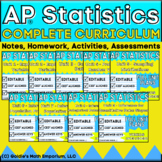Goldie’s AP® Statistics UNIT 4 PLANS – Probability and Random Variables
- Zip
What educators are saying
Also included in
- AP® Statistics Full CurriculumIn this product, you will receive all of Goldie's products related to AP® Statistics. All 9 units follow the College Board's© CED and include the following:Student Guided NotesStudent notes are "fill in the blank" style notes; teachers lead the lesson and work with studPrice $265.00Original Price $311.50Save $46.50
- This resource contains the COMPLETE unit plans for AP Statistics Unit 1 thru 4. In this product, you will receive everything I use the teach AP Statistics in the first semester of the school year. Take a look at each individual unit plan preview to see what is included! Unit 1 - Exploring One VariabPrice $110.00Original Price $140.00Save $30.00
Description
AP Statistics Unit 4 – Probability, Random Variables, and Probability Distributions
Unit Bundle
This unit contains everything you need to teach "Probability, Random Variables, and Probability Distributions" in AP® Statistics or regular-level Statistics. Students will go through how to calculate and interpret basic probabilities, conditional probabilities, and probabilities for the union and interception of two events; represent and interpret the probabilities for discrete and continuous random variables; calculate parameters for linear combinations of random variables and describe the effects of linear transformations of parameters; and calculate and interpret probabilities for a binomial and geometric probability distribution.
This unit is part of my larger unit bundle: Goldie's AP® Statistics Full Curriculum
This product is a zip folder with the following items:
- 8 complete sets of student-guided notes (annotated answer keys included)
- Videos to accompany each set of notes - perfect for a flipped classroom or distance learning needs
- 2 in-class review student handouts (with teacher slides included!)
- 10 homework problem sets + complete test review (annotated answer keys included)
- 3 assessments - 2 quizzes and a test (answer keys included)
- 7 activities and projects
- 2 additional lessons that teach combinations/permutations and the Poisson distribution
- Suggested pacing and learning targets
All of the resources are 100% editable, so you are able to modify to fit your classroom needs. The zip folder includes all the Word documents for the resources, which you have permission to edit. The PDF version and answer keys are included for your convenience.
I teach this course without a textbook, so everything that is provided here, can be used without supplementation. The only thing I use in my class that is NOT included in this content is the secured AP® exam questions.
************************************************************************************
Interested in other units? Check them out below!
Unit 1 - Exploring One Variable Data
Unit 2 - Exploring Two Variable Data
Unit 4 - Probability, Random Variables, and Probability Distributions
Unit 5 - Sampling Distributions
Unit 6 - Inference for Categorical Data: Proportions
Unit 7 - Inference for Quantitative Data: Means
Unit 8 - Inference for Categorical Data: Chi-Square
Unit 9 - Inference for Quantitative Data: Slopes
---OR---
AP® Statistics FULL CURRICULUM Bundle
If you are interested in specific resources, you can check out my resources bundles:
AP® Statistics Homework Bundle
AP® Statistics Assessments Bundle
AP® Statistics Guided Notes Bundle
AP® Statistics Projects and Activities Bundle
************************************************************************************
If you need extra explanations or guidance, I would love to help!! Contact me at goldiesmathemporium[at]gmail.com for any questions or samples.
I want to provide the best possible resources to help other teachers out! You will be notified of any future updates and additions to this product and it will be free of charge. Your support is important and I thank you for allowing me to continue doing what I love to do.
AP® is a trademark registered by the College Board®, which is not affiliated with, and does not endorse, this product.
Note: I am not affiliated with nor endorsed by any textbook or other curriculum provider. I am a classroom teacher who creates curriculum materials to help other teachers.
© Goldie’s Math Emporium, LLC
This work is bound by copyright laws and editing (beyond your own classroom use), selling, redistributing, or posting all or part of these documents on the Internet is strictly prohibited. Violations are subject to the Digital Millennium Copyright Act.







